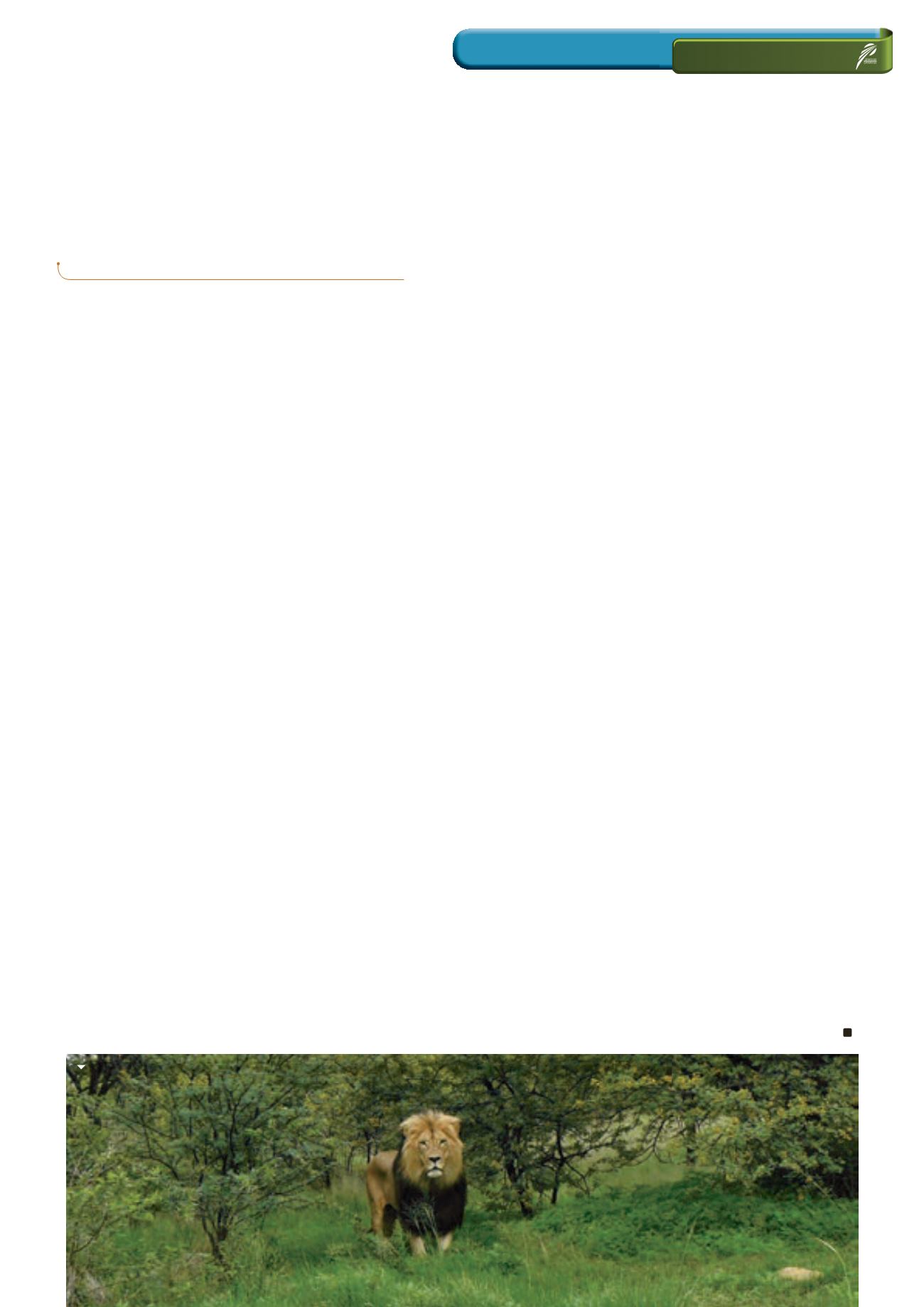

Illegal poisoning of wildlife
on the increase
T
he recent death of vultures, blue cranes, brown hyaenas
and other wildlife due to illegal poisoning should be a wake-
up call for South African conservation authorities, law
enforcement agencies and conservationists. While rhinos
are faced with a grave poaching threat, other equally important
wildlife species, especially scavengers and predators are at risk of
joining rhinos on the route of steep decline if the current spate of
illegal poisoning continues.
The recent death of 66 vultures in the Lowveld was confirm-
ed by toxicological analysis as a poisoning case; at least one
carbamate pesticide was detected in the analysis. More recent
incidents in which ungulates were snared and their carcasses
poisoned to kill vultures for traditional medicine are just the tip of
the iceberg.
In 2012 mass poisoning of blue cranes occurred in the Karoo.
This is as yet unresolved. Recently producers reported that at
least 16 brown hyaenas died in the Limpopo Province, probably
as a result of poisoning, and earlier this year black-backed jackals
were deliberately poisoned in the Addo Elephant National Park.
Poisoned baits aimed at rhinos are often found in the Kruger
National Park and associated private nature reserves. Fortunately,
no rhinos have been poisoned to date in this important conserva-
tion area. Unfortunately many of the wildlife poisoning incidents
become “cold cases” as the culprits are never found.
Deliberate poisoning of wildlife is definitely on the increase. Some
of the poisonings are committed by poachers who kill wildlife for
traditional medicine; vultures are mostly targeted for their heads
that are used in divination. Lions have also allegedly been poisoned
for their bones as part of the lion bone trade that services the Far
East. Elephants have been poisoned in Zimbabwe to obtain their
ivory, probably also for the lucrative illegal ivory trade in the Far East.
What is of grave concern is the illegal use of pesticides and other
poisons such as sodiummonofluoroacetate by the owners of
livestock and wildlife in order to kill predators. Despite a concerted
effort by the livestock industry driven Predation Management
Forum (PMF) to offer producers alternatives to poisoning predators,
some individuals do not heed to warnings to refrain from the illegal
use of pesticides and poisons.
Provincial conservation agencies have warned that the liberal
distribution and use of sodiummonofluoroacetate (also known as
Compound 1080) is illegal, and should any retailer or landowner be
found in possession of it, they will be prosecuted. There is reason
to believe that vultures in the Eastern Cape and the 16 brown
hyaenas in Limpopo were poisoned with Compound 1080; further
investigations are geared to identify the particular toxins that were
used to kill these animals.
State departments are at a loss for funds to conduct toxicological
analysis and often request the Griffon Poison Information Centre
to fund such analyses. Villa Crop Protection, one of the largest
agricultural remedy suppliers in the country, supports the centre
with financial backing to conduct toxicological analysis.
Villa Crop MD, Dr André Schreuder, says “Illegal poisoning of wildlife
is a huge risk not only to South Africa’s natural environment, but
also to agriculture. Many of our important products are deliberately
misused to poison animals. It creates a negative perception of
agricultural remedies if criminals misuse them to poison wildlife.
Villa is determined to undermine individuals who poison wildlife
illegally, by supporting investigations into their crimes.”
Mr Tommy Fraser, a director of Villa Crop Protection, game pro-
ducer and conservationist believes that a concerted effort is re-
quired from conservationists, producers and law enforcement
agencies to stem the poisoning of wildlife: “Poisoning is like a death
warrant to all life forms. It hits far beyond the scope of the intend-
ed target. If nothing is done, we may not see our rare birds, such as
vultures, fly into the 22nd Century”.
Livestock owners that experience stock losses due to predation
are likely to consider poison as a remedy. Only the poison collar
is legal and only after a permit is obtained from the conservation
authorities. It is well-known that aldicarb, carbofuran, methomyl and
Compound 1080 are illegally used to poison predators. The results
are devastating and over the past two years many vultures have
perished at the hands of those who lay out poisoned baits.
The Griffon Poison Information Centre endeavours to rid the country
of illegal poisoning. Its supporters, many of which are producers,
are gathering intelligence on those individuals who illegally poison
wildlife. On the other hand it is offering a hand of assistance via the
Predation Management Forum to mitigate predation. Information
and assistance may be requested via
www.pmfsa.co.za .Any information about illegal wildlife poisoning may be called into
082 446 8946 or
nesher@tiscali.co.za .For more information, call Dr Gerhard Verdoorn at 082 446 8946.
101
October 2015
RELEVANT
GERHARD H VERDOORN,
Griffon Poison Information Centre
SA Grain/
Sasol Chemicals (Fertiliser) photo competition
Lions have also allegedly been poisoned for their bones as part of the lion bone trade that services the Far East.

















